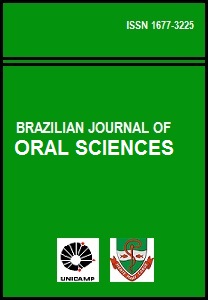Abstract
Aim: To evaluate the effects of radioiodine therapy on salivary flow in patients with differentiated thyroid cancer. Methods: A sample comprising 88 patients submitted to ablation with iodine 131 was included in the study. The patients were submitted to sialometry and evaluation of the presence of xerostomia before, 10 days and 3 months after radioiodine therapy. Results: Xerostomia was observed in 36.4% of the patients before radioiodine therapy, 59.15% at 10 days after therapy, and 25% at 3 months after therapy. Significant differences were observed in non-stimulated salivary flow rates between the second and third evaluations (p<0.020) and in stimulated salivary flow between the first and second evaluations (p<0.010). Conclusions: The results suggest that changes in salivary flow resulting from radioiodine therapy are more pronounced during the first weeks after treatment and seem to regress after 3 months.
This work is licensed under a Creative Commons Attribution 4.0 International License.
Copyright (c) 2015 Anna Clara Fontes Vieira, Aline Sampaio Lima Rodrigues, Maria Carmen Fontoura Nogueira da Cruz, Fernanda Ferreira Lopes
Downloads
Download data is not yet available.

